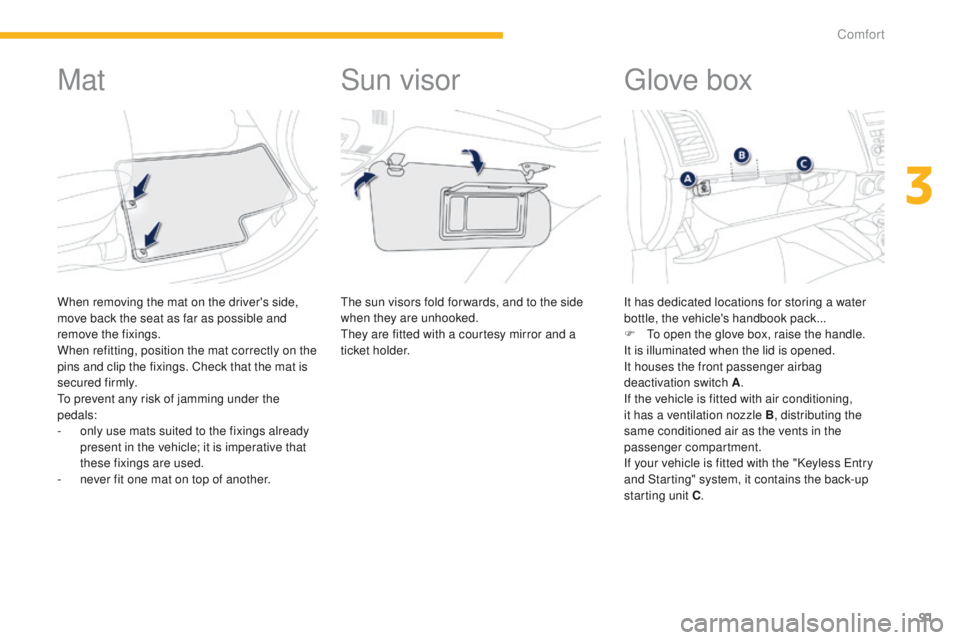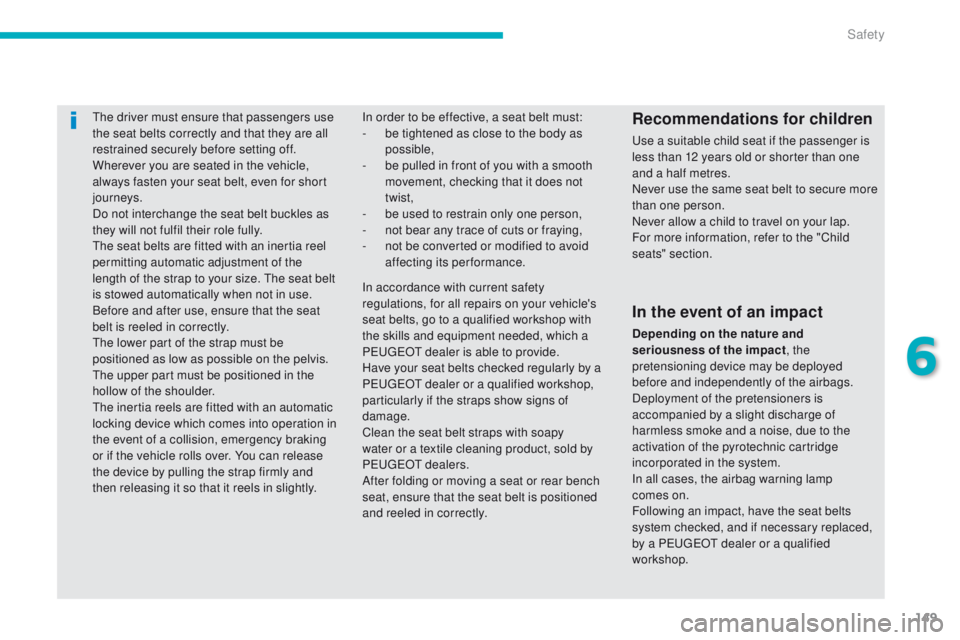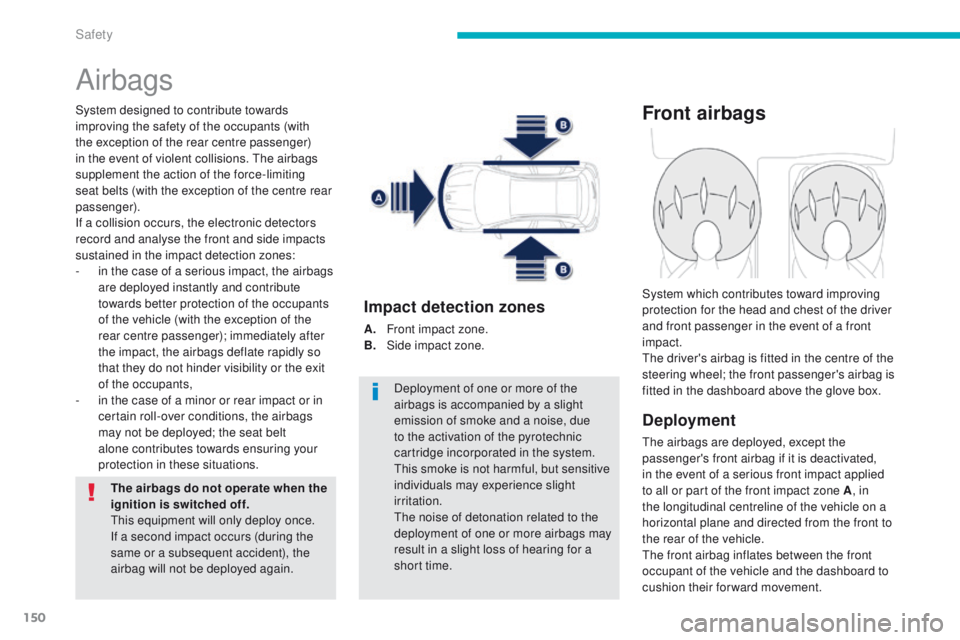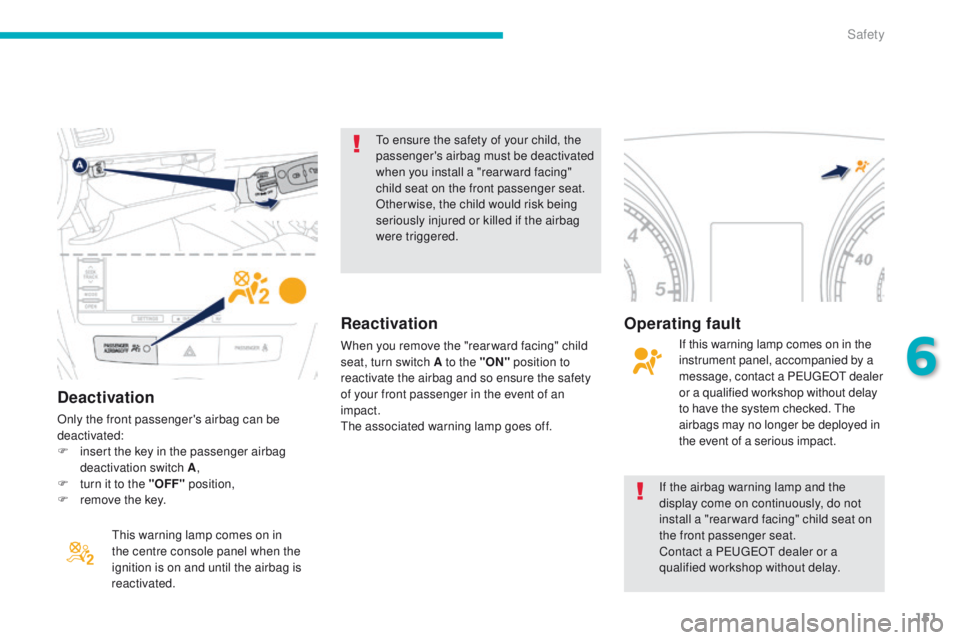2014.5 PEUGEOT 4008 airbag
[x] Cancel search: airbagPage 5 of 389

Direction indicators 141
Hazard warning lamps
1
41
H o r n
141
Braking assistance systems
1
42
tr
ajectory control systems
1
44
Front seat belts
1
46
Airbags
150
Child seats
1
55
Deactivating the passenger's front airbag
1
57
ISOFIX child seats
1
64
Child lock
1
70
Safety
temporary puncture repair kit 1 71
Changing a wheel
1
75
Snow chains
1
81
Changing a bulb
1
82
Changing a fuse
1
88
12 V battery
1
94
Automatic power cut-off to accessories
1
97
Changing a wiper blade
1
97
Recovering the vehicle
1
98
to
wing a trailer
2
01
Fitting roof bars
2
03
Accessories
204
Practical information
Bonnet 207
Petrol engines
2
08
Diesel engines
2
09
Fuel tank
2
10
Running out of fuel (Diesel)
2
12
Checking levels
2
13
Checks
216
Checks
Petrol engines 2 19
Petrol weights
2
20
Diesel engines
2
26
Diesel weights
2
27
Dimensions
233
Identification markings
2
35
technical data
Bluetooth® telephone with voice
recognition 237
to
uch screen A
uD
IO -
t
e
LeM
A
tI
C
system
249
tOuC
H SCR
e
e
N AuD
IO - CD system
2
89
A
uD
IO - CD system
3
11
Audio equipment and telematics
Alphabetical index
Contents
Page 10 of 389

8
A. Passenger's airbag deactivation warning lamp. 1 51
B.
H
azard warning lamps.
1
41
C.
F
ront passenger's seat belt not
fastened or unfastened.
1
47
Central switch panel
Instruments and controls (continued)
A. Manual headlamp adjustment. 133
B. Deactivation of the ASC/tC L system. 14 4
C. D
eactivation of the parking
sensors.
125
D.
D
eactivation of the Stop & Start
(Auto Stop &
g
o
) function.
1
12
Side switch panel
Over view
Page 17 of 389

15
Warning/indicator lampis on Cause Action / Observations
Anti-lock
Braking System
(ABS) fixed.
th
e anti-lock braking system has a
fault.
th
e vehicle retains conventional braking.
Drive carefully at reduced speed and contact a P
e
uge
Ot
dealer or a qualified workshop without delay.
Front seat belt
not fastened /
unfastened
fixed, then flashing,
accompanied by
an audible signal.the driver has not fastened or has
unfastened their seat belt.
Pull the strap, then insert the tongue in the buckle.
Airbags and
pretensioners temporarily.
When you switch on the ignition, this
warning lamp comes on for a few
seconds, then goes off. If it does not go off, contact a P
e
uge
Ot
dealer or a
qualified workshop.
fixed. Fault with one of the airbag or seat
belt pretensioner systems. Have it checked by a P
e
uge
Ot
dealer or a qualified
workshop.
Under-inflation fixed,
accompanied by
a message
th
e tyre pressure for one or more
wheels is too low. Check the tyre pressures as soon as possible.
th
is check should preferably be done with the tyres cold.
You must reinitialise the system after every adjustment of
one or more tyre pressures and after replacing one or more
wheels.
For more information refer to the "
un
der-inflation detection"
section.
flashing
then fixed,
accompanied by
a message.
th
e system has a fault and/or one
or more wheels does not have a
detected sensor.
th
e tyre pressures are no longer monitored.
Have the system checked by a Peuge
O
t dealer or a
qualified workshop.
1
Monitoring
Page 29 of 389

27
Screen 1 Screen 2Cause Solution - ActionObservations
You have moved off with the parking
brake not fully released. Release the parking brake.
th
e oil pressure is too low or there
is a fault with the engine lubrication
system. Stop the vehicle and contact
a P
e
uge
Ot
dealer or a qualified
workshop.
Battery charge fault. Stop the vehicle and contact
a P
e
uge
Ot
dealer or a qualified
workshop.
Airbag or pretensioner fault. Contact a P
e
uge
Ot
dealer or
a qualified workshop to have the
systems checked.
Fault with automatic headlamp
adjustment system. Contact a P
e
uge
Ot
dealer or
a qualified workshop. Only on vehicles fitted with xenon
headlamps.
Fault with the stability control
system (ASC). Contact a P
e
uge
Ot
dealer or
a qualified workshop.
Fault with the four wheel drive
transmission system. Contact a P
e
uge
Ot
dealer or
a qualified workshop.
1
Monitoring
Page 93 of 389

91
Mat
When removing the mat on the driver's side,
move back the seat as far as possible and
remove the fixings.
When refitting, position the mat correctly on the
pins and clip the fixings. Check that the mat is
secured firmly.
to p
revent any risk of jamming under the
pedals:
-
o
nly use mats suited to the fixings already
present in the vehicle; it is imperative that
these fixings are used.
-
n
ever fit one mat on top of another.
Sun visorgl ove box
It has dedicated locations for storing a water
bottle, the vehicle's handbook pack...
F
t
o o
pen the glove box, raise the handle.
It is illuminated when the lid is opened.
It houses the front passenger airbag
deactivation switch A .
If the vehicle is fitted with air conditioning,
it has a ventilation nozzle B , distributing the
same conditioned air as the vents in the
passenger compartment.
If your vehicle is fitted with the "Keyless
e
n
try
and Starting" system, it contains the back-up
starting unit C .th
e sun visors fold for wards, and to the side
when they are unhooked.
th
ey are fitted with a courtesy mirror and a
ticket holder.
3
Comfort
Page 151 of 389

149
the driver must ensure that passengers use
the seat belts correctly and that they are all
restrained securely before setting off.
Wherever you are seated in the vehicle,
always fasten your seat belt, even for short
journeys.
Do not interchange the seat belt buckles as
they will not fulfil their role fully.
th
e seat belts are fitted with an inertia reel
permitting automatic adjustment of the
length of the strap to your size.
t
h
e seat belt
is stowed automatically when not in use.
Before and after use, ensure that the seat
belt is reeled in correctly.
th
e lower part of the strap must be
positioned as low as possible on the pelvis.
th
e upper part must be positioned in the
hollow of the shoulder.
th
e inertia reels are fitted with an automatic
locking device which comes into operation in
the event of a collision, emergency braking
or if the vehicle rolls over. You can release
the device by pulling the strap firmly and
then releasing it so that it reels in slightly.Recommendations for children
use a suitable child seat if the passenger is
less than 12 years old or shorter than one
and a half metres.
Never use the same seat belt to secure more
than one person.
Never allow a child to travel on your lap.
For more information, refer to the "Child
seats" section.
In order to be effective, a seat belt must:
-
b
e tightened as close to the body as
possible,
-
b
e pulled in front of you with a smooth
movement, checking that it does not
twist,
-
b
e used to restrain only one person,
-
n
ot bear any trace of cuts or fraying,
-
n
ot be converted or modified to avoid
affecting its performance.
In the event of an impact
Depending on the nature and
seriousness of the impact , the
pretensioning device may be deployed
before and independently of the airbags.
Deployment of the pretensioners is
accompanied by a slight discharge of
harmless smoke and a noise, due to the
activation of the pyrotechnic cartridge
incorporated in the system.
In all cases, the airbag warning lamp
comes
on.
Following an impact, have the seat belts
system checked, and if necessary replaced,
by a P
e
uge
Ot
dealer or a qualified
workshop.
In accordance with current safety
regulations, for all repairs on your vehicle's
seat belts, go to a qualified workshop with
the skills and equipment needed, which a
P
e
uge
Ot d
ealer is able to provide.
Have your seat belts checked regularly by a
P
e
uge
Ot
dealer or a qualified workshop,
particularly if the straps show signs of
damage.
Clean the seat belt straps with soapy
water or a textile cleaning product, sold by
P
e
uge
Ot d
ealers.
After folding or moving a seat or rear bench
seat, ensure that the seat belt is positioned
and reeled in correctly.
6
Safety
Page 152 of 389

150
Airbags
System designed to contribute towards
improving the safety of the occupants (with
the exception of the rear centre passenger)
in the event of violent collisions. t
h
e airbags
supplement the action of the force-limiting
seat belts (with the exception of the centre rear
passenger).
If a collision occurs, the electronic detectors
record and analyse the front and side impacts
sustained in the impact detection zones:
-
i
n the case of a serious impact, the airbags
are deployed instantly and contribute
towards better protection of the occupants
of the vehicle (with the exception of the
rear centre passenger); immediately after
the impact, the airbags deflate rapidly so
that they do not hinder visibility or the exit
of the occupants,
-
i
n the case of a minor or rear impact or in
certain roll-over conditions, the airbags
may not be deployed; the seat belt
alone contributes towards ensuring your
protection in these situations.
The airbags do not operate when the
ignition is switched off.
th
is equipment will only deploy once.
If a second impact occurs (during the
same or a subsequent accident), the
airbag will not be deployed again. Deployment of one or more of the
airbags is accompanied by a slight
emission of smoke and a noise, due
to the activation of the pyrotechnic
cartridge incorporated in the system.
th
is smoke is not harmful, but sensitive
individuals may experience slight
irritation.
th
e noise of detonation related to the
deployment of one or more airbags may
result in a slight loss of hearing for a
short time.
Impact detection zones
A. Front impact zone.
B. S ide impact zone.
Front airbags
Deployment
the airbags are deployed, except the
passenger's front airbag if it is deactivated,
in the event of a serious front impact applied
to all or part of the front impact zone A , in
the longitudinal centreline of the vehicle on a
horizontal plane and directed from the front to
the rear of the vehicle.
th
e front airbag inflates between the front
occupant of the vehicle and the dashboard to
cushion their forward movement. System which contributes toward improving
protection for the head and chest of the driver
and front passenger in the event of a front
impact.
th
e driver's airbag is fitted in the centre of the
steering wheel; the front passenger's airbag is
fitted in the dashboard above the glove box.
Safety
Page 153 of 389

151
Deactivation
Only the front passenger's airbag can be
deactivated:
F
i
nsert the key in the passenger airbag
deactivation switch A ,
F
t
urn it to the "OFF" position,
F
r
emove the key.
th
is warning lamp comes on in
the centre console panel when the
ignition is on and until the airbag is
reactivated.
to e
nsure the safety of your child, the
passenger's airbag must be deactivated
when you install a "rear ward facing"
child seat on the front passenger seat.
Otherwise, the child would risk being
seriously injured or killed if the airbag
were triggered.
If the airbag warning lamp and the
display come on continuously, do not
install a "rear ward facing" child seat on
the front passenger seat.
Contact a P
e
uge
Ot
dealer or a
qualified workshop without delay.
Reactivation
When you remove the "rear ward facing" child
seat, turn switch A to the "ON" position to
reactivate the airbag and so ensure the safety
of your front passenger in the event of an
impact.
th
e associated warning lamp goes off.
Operating fault
If this warning lamp comes on in the
instrument panel, accompanied by a
message, contact a P
e
uge
Ot
dealer
or a qualified workshop without delay
to have the system checked.
t
h
e
airbags may no longer be deployed in
the event of a serious impact.
6
Safety